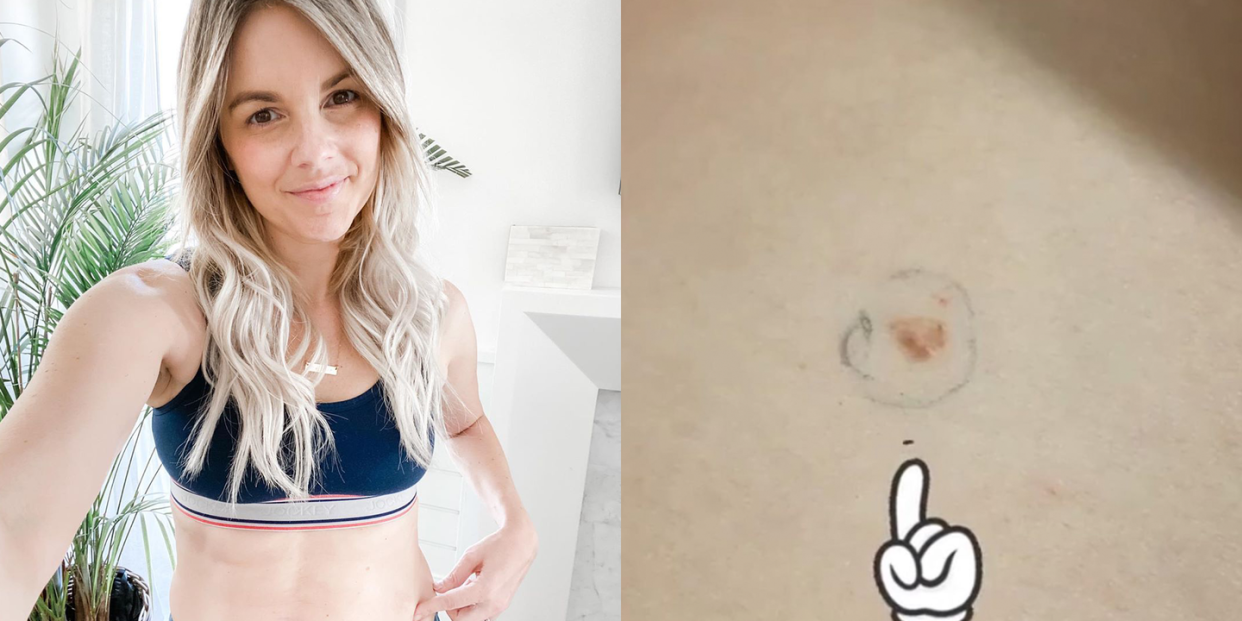‘Bachelorette’ Star Ali Fedotowsky Just Shared Up-Close Pictures of Her Skin Cancer

Former Bachelorette star Ali Fedotowsky revealed that she has the most common form of skin cancer, basal cell carcinoma, on Instagram.
Fedotowsky shared pictures of her cancerous mole, as well as her surgery scar on her stomach.
She hopes her story will encourage others to apply sunscreen regularly.
Former Bachelorette star Ali Fedotowsky made a surprising announcement to her fans: She has skin cancer. “GET YOUR SKIN CHECKED,” she wrote alongside several photos posted to Instagram. “When my dermatologist used the c-word, I just about fainted in his office.”
Fedotowsky confirmed she has basal cell carcinoma, the most common type of skin cancer, which “is rarely fatal and really never fatal when you catch it early,” she said. “Needless to say, I’m never exposing my stomach to sun without sunscreen again!”
Fedotowsky also said she’s “lucky it wasn’t melanoma,” which is the deadliest form of skin cancer, and that she spotted it early. “The scar right above my belly button is from when I had cells/skin that may be cancerous removed six months ago,” she added.
A post shared by Ali Manno (Fedotowsky) (@alifedotowsky) on Jan 23, 2020 at 12:37pm PST
What does basal cell carcinoma look like?
About 2 million Americans are diagnosed with basal cell carcinoma each year, according to the American Academy of Dermatology (AAD). This form of cancer develops in basal cells, which are found in the lower part of your epidermis (the top layer of your skin).
It often pops up on the face, neck, or ears, and looks like a shiny, raised, and round growth. People can mistake it for a pimple that won’t go away. Warning signs to watch for include:
Flat, firm, or pale and yellowish areas that resemble a scar
Pearly, translucent, or shiny bumps or spots
Red or pink raised patches that may also itch
Open scabs or sores that don’t heal or heal and come back
Oozing or crusted areas that bleed easily
Growth of a bump or lesion over time
“These spots are caused by chronic sun exposure,” says Gary Goldenberg, M.D., assistant clinical professor of dermatology at the Icahn School of Medicine at Mount Sinai in New York City. “Traditionally they are found in older patients, but the number of basal cell skin cancer I’ve seen in younger patients is increasing.”
What happens after a skin cancer diagnosis?
If your dermatologist finds a suspicious lesion, they’ll usually biopsy it and send it to a lab for testing, says Joshua Zeichner, M.D., a board-certified dermatologist in New York City. If the biopsy comes back positive, the lesion will typically be removed by cutting out the skin cancer and an area of normal-looking skin around it. (Removing normal-looking skin helps to remove any potential stray cancer cells, the AAD says.)
“The spot may be scraped, removed surgically, or be removed using a specialized surgical technique known as Mohs surgery. This is usually done on areas of the body where there is not room to take adequate margins (areas of clear skin), such as on the face,” he explains. “Chemotherapy creams can also treat some forms topically.”
After that, it’s generally recommended that you regularly have your skin inspected by a dermatologist. Every doctor is different, but Dr. Zeichner recommends his patients come back every six months. And follow-ups are crucial, Dr. Goldenberg adds. “If you’re diagnosed with a basal cell skin cancer, your risk for having another skin cancer is higher than general population,” he says.
Fedotowsky later went on her Instagram Stories to talk more about her experience and reassure fans that she’s okay. “It’s not serious, so don’t worry,” she said. She later revealed that her new morning routine is to “douse” herself with sunscreen. “I really want to encourage you all to do the same,” she said.
Like what you just read? You’ll love our magazine! Go here to subscribe. Don’t miss a thing by downloading Apple News here and following Prevention. Oh, and we’re on Instagram too.
You Might Also Like

